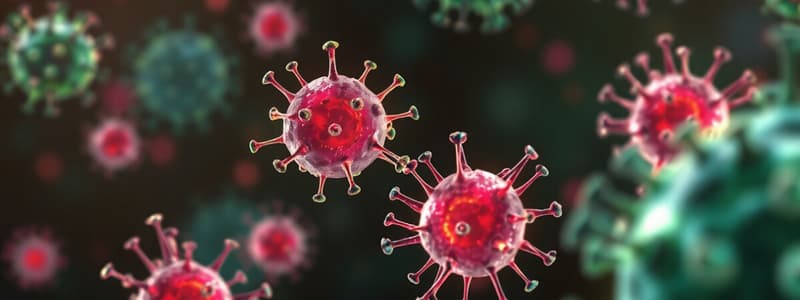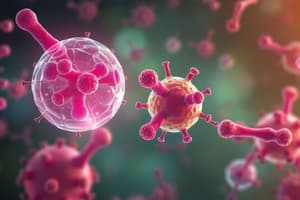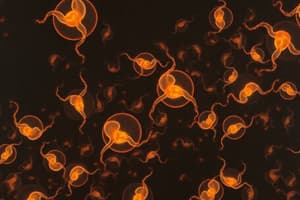Podcast
Questions and Answers
How does adaptive immunity differ from innate immunity?
How does adaptive immunity differ from innate immunity?
- Adaptive immunity does not involve lymphocytes.
- Adaptive immunity responds immediately to pathogens.
- Adaptive immunity targets specific invaders and their products. (correct)
- Adaptive immunity lacks the ability to recognize antigens.
Which characteristic is a key attribute of adaptive immunity?
Which characteristic is a key attribute of adaptive immunity?
- Immediate response to any foreign invader
- Specificity in recognizing unique antigens (correct)
- Lack of memory for previously encountered antigens
- Functionality from birth, without prior exposure
What is the primary role of B lymphocytes in adaptive immunity?
What is the primary role of B lymphocytes in adaptive immunity?
- Producing antibodies to target extracellular pathogens (correct)
- Presenting antigens to T lymphocytes
- Suppressing the immune response to prevent autoimmunity
- Directly attacking infected cells
How do T lymphocytes contribute to adaptive immunity?
How do T lymphocytes contribute to adaptive immunity?
What is the role of antigens in adaptive immunity?
What is the role of antigens in adaptive immunity?
What role do Major Histocompatibility Complexes (MHC) play in adaptive immunity?
What role do Major Histocompatibility Complexes (MHC) play in adaptive immunity?
How do antigen-presenting cells (APCs) facilitate adaptive immunity?
How do antigen-presenting cells (APCs) facilitate adaptive immunity?
What is the significance of T Cell Receptors (TCR) in adaptive immunity?
What is the significance of T Cell Receptors (TCR) in adaptive immunity?
What triggers the mass production of T and B cells during an adaptive immune response?
What triggers the mass production of T and B cells during an adaptive immune response?
What is the primary role of cytokines in adaptive immunity?
What is the primary role of cytokines in adaptive immunity?
How do cytotoxic T lymphocytes (Tc) eliminate infected cells?
How do cytotoxic T lymphocytes (Tc) eliminate infected cells?
What is the function of helper T lymphocytes (Th) in adaptive immunity?
What is the function of helper T lymphocytes (Th) in adaptive immunity?
Which of the following best describes exogenous antigens?
Which of the following best describes exogenous antigens?
How does Interleukin 4 contribute to B cell activation?
How does Interleukin 4 contribute to B cell activation?
Which immunoglobulin is associated with body secretions, such as mucous membranes?
Which immunoglobulin is associated with body secretions, such as mucous membranes?
What role do regulatory T lymphocytes play in adaptive immunity?
What role do regulatory T lymphocytes play in adaptive immunity?
Which type of antigen is produced by microbes that reproduce inside a body's cells?
Which type of antigen is produced by microbes that reproduce inside a body's cells?
What is the function of memory B lymphocytes in adaptive immunity?
What is the function of memory B lymphocytes in adaptive immunity?
Which antibody is typically the first antibody produced during an acute infection?
Which antibody is typically the first antibody produced during an acute infection?
Which statement accurately describes the function of antibodies?
Which statement accurately describes the function of antibodies?
How does vaccination contribute to adaptive immunity?
How does vaccination contribute to adaptive immunity?
Which of the following is NOT a way that antibodies assist in clearing infections?
Which of the following is NOT a way that antibodies assist in clearing infections?
Autoantigens are displayed as what?
Autoantigens are displayed as what?
Interleukin 12 can be produced by the APC causing the Th to become what?
Interleukin 12 can be produced by the APC causing the Th to become what?
What is the purpose of costimulation of T/B and APC cells?
What is the purpose of costimulation of T/B and APC cells?
Flashcards
Adaptive Immunity
Adaptive Immunity
The body's ability to recognize and defend against specific invaders and their products.
Antigens
Antigens
Molecules that the body recognizes as foreign and worthy of attack.
Epitopes
Epitopes
The three-dimensional regions on antigens that are recognized by the immune system.
Exogenous Antigens
Exogenous Antigens
Signup and view all the flashcards
Endogenous Antigens
Endogenous Antigens
Signup and view all the flashcards
Autoantigens
Autoantigens
Signup and view all the flashcards
Major Histocompatibility Complexes (MHC)
Major Histocompatibility Complexes (MHC)
Signup and view all the flashcards
Antigen Presenting Cell (APC)
Antigen Presenting Cell (APC)
Signup and view all the flashcards
MHC I
MHC I
Signup and view all the flashcards
MHC II
MHC II
Signup and view all the flashcards
T Cell Receptor (TCR)
T Cell Receptor (TCR)
Signup and view all the flashcards
B Cell Receptors (BCR)
B Cell Receptors (BCR)
Signup and view all the flashcards
Costimulation
Costimulation
Signup and view all the flashcards
Cytokines
Cytokines
Signup and view all the flashcards
Cytotoxic T Lymphocyte (T8, Tc)
Cytotoxic T Lymphocyte (T8, Tc)
Signup and view all the flashcards
Helper T Lymphocyte (T4, Th)
Helper T Lymphocyte (T4, Th)
Signup and view all the flashcards
Memory T Lymphocytes
Memory T Lymphocytes
Signup and view all the flashcards
Regulatory T Lymphocyte
Regulatory T Lymphocyte
Signup and view all the flashcards
Antibodies
Antibodies
Signup and view all the flashcards
IgM
IgM
Signup and view all the flashcards
IgG
IgG
Signup and view all the flashcards
IgA
IgA
Signup and view all the flashcards
IgE
IgE
Signup and view all the flashcards
Antibody effects
Antibody effects
Signup and view all the flashcards
Vaccination
Vaccination
Signup and view all the flashcards
Study Notes
- Chapter 16 discusses Adaptive Immunity
Overview of Adaptive Immunity
- Adaptive immunity aids in recognizing and defending the body against specific invaders and their products
- Adaptive immunity is not functional at birth
- Adaptive immunity attributes include:
- Specificity due to recognition of unique antigens
- Memory to the same antigens
Lymphocytes
- Adaptive immunity activities includes Lymphocytes
- The two main types of lymphocytes are B and T lymphocytes
B Lymphocytes
- Humoral Immunity: Targets attacking invaders outside of cells, specifically in the blood
- Target extracellular pathogens/toxins
T Lymphocytes
- Cell Mediated Immunity: Targets attacking infected cells inside the cells, kills cells that are already infected
- Targets intracellular pathogens
Antigens
- Both T and B cells require recognition of Antigens
- Antigens are molecules (surface protein, carb, lipid) the body recognizes as foreign and worthy of attack
- Primarily
- Three basic types:
- Exogenous antigens are found outside a body's cells, including toxins, microbial cell walls, membranes, flagella, and pili.
- Endogenous antigens are produced by microbes that reproduce inside a body's cells (replicating)
- Autoantigens are self-made antigens been made by our DNA
Epitopes
- Antigens are recognized by three-dimensional regions called epitopes
Elements of Adaptive Immunity
- Epitopes are recognized by the lymphocytes when displayed as Major Histocompatibility Complexes (MHC)
- Major histocompatibility complexes are glycoproteins found in the membranes of most cells
- MHC and position epitopes for presentation to immune cells
- A cell that presents the antigen to the lymphocytes is called an Antigen Presenting Cell (APC)
MHC Proteins
- Two types of MHC proteins
- MHC I is present on all nucleated cells, with the exception of red blood cells
- MHC II is present on antigen presenting cells (APCs)
- Wandering types: Macrophages, dendritic cells, and B cells
Antigen Processing
- Autoantigens are displayed as self MHC's
- Endogenous and exogenous antigens are processed into MHC proteins to display the pathogen epitopes
- MHC I is present if a nucleated cell (fixed)
- MHC I and MHC II are present if an antigen presenting cell (APC)
Lymphocyte Recognition
- T and B cells are able to recognize the pathogen displayed MHC's
- T cells have a T Cell Receptor (TCR) protein unique for each pathogen epitope
- A matching TCR exists for every possible epitope a person may contact
- B cells have B Cell Receptors (BCR) unique to pathogen epitopes (once again for all possible epitopes)
- Divisions of T and B cells occurs once recognition happens
Antigen Presenting Cell (APC) Recognition
- Recognition usually requires an Antigen Presenting Cell (APC)
- Examples: Macrophage, B cell, Dendritic Cell
- Interaction between T/B and APC is required to multiply the number of T/B cells
- This interaction is called Costimulation
- Costimulation results from surface molecules on each cell and release of Cytokines
Immune Response Cytokines
- Interleukins (ILs) signal among leukocytes
- Interferons (IFNs) are antiviral proteins that may act as cytokines
- Growth factors are proteins that stimulate stem cells to divide
- Tumor necrosis factor (TNF) is secreted by macrophages and T cells to kill tumor cells and regulate immune responses and inflammation
Production of T/B Cells
- Recognition and costimulation leads to a mass production of T/B cells to attack the foreign epitopes
T Cell Activation
- Cell mediated-attack of infected cells
- Cytotoxic T lymphocyte (T8, Tc): Facilitates the attacking and killing
- Directly kills other cells with perforins, punch holes in the cell
- Helper T lymphocyte (T4, Th): Helps make the army
- Helps multiply B cells and cytotoxic T cells
- Includes type 1 (Th1) and type 2 (Th2)
- Memory T lymphocytes
- Remember same epitope in the future, B cells will use the future
- Regulatory T lymphocyte inhibits autoantigen attack
- Prevents self attack for auto immune diseases
Cell-Mediated Immune Response
- Infected cells display MHC I foreign epitopes, endogenous antigens
- APC displays both MHC I and MHC II
- Interleukin 12 triggers the APC to cause Th to become Th1
- Interleukin 2 is produced by both Th1 and Tc
- TC now attacks infected cells displaying MHC1 endogenous
B Cell Activation
- Humoral Immunity: attacking in the blood before getting into cells
- Production of ANTIBODIES to attack extracellular epitopes
- Lymphocyte types:
- B lymphocytes
- Initially recognizes foreign epitopes; act as APC
- Becomes plasma cells
- Plasma cells produce antibodies
- Helper T lymphocytes (T4, Th)
- Helps multiply B cells and cytotoxic T cells
- Includes type 1 (Th1) and type 2 (Th2) using these cells now
- Memory B lymphocytes
- Remembers same epitope in the future
- Allows us to not get the same infection again
- B lymphocytes
Important B-Cells Points
- APC’s (both dendritic and B) displays MHC II
- Interleukin 4 causes Th to become Th2
- Interleukin 4 also causes B cell to become Plasma cells
- Antibodies from Plasma Cells attack exogenous antigens
Antibody Properties
- Basic Structure
- Two heavy chains, two light chains
- Each chain has a variable region that creates an Antigen Binding Site
- A site is epitope specific
- The stem of the heavy chains leads to different types of antibodies
Types of Antibodies
- IgM is the first antibody produced (acute)
- IgG is the most common and longest-lasting (chronic)
- IgA associated with body secretions (mucous membrane)
- IgE is involved in response to parasitic infections and allergies
- The exact function of IgD is unknown
- IG = immunoglobulin
Antibodies
- Antibodies have a specific effect
- Phagocytosis
- Lysis
- Agglutination (clumping); attaches microbes together
- Neutralize
- Antibodies do not kill microbes; they assist to get them killed
Gaining Memory
- Obtaining memory against a specific epitope is to Vaccinate
Studying That Suits You
Use AI to generate personalized quizzes and flashcards to suit your learning preferences.




